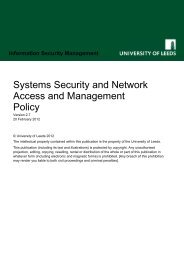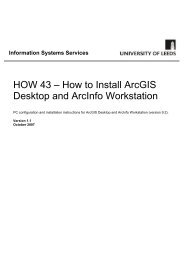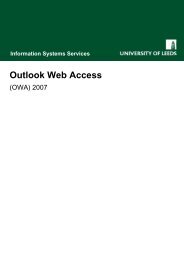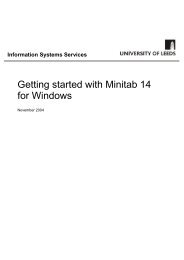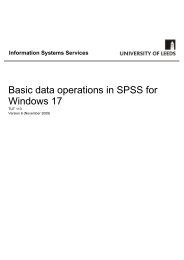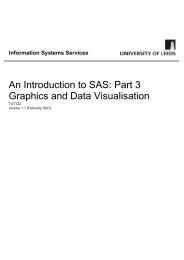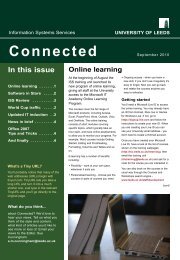Fitting Curves and Surfaces Using SAS Software - ISS - University of ...
Fitting Curves and Surfaces Using SAS Software - ISS - University of ...
Fitting Curves and Surfaces Using SAS Software - ISS - University of ...
Create successful ePaper yourself
Turn your PDF publications into a flip-book with our unique Google optimized e-Paper software.
<strong>Fitting</strong> <strong>Curves</strong> <strong>and</strong> <strong>Surfaces</strong> <strong>Using</strong> <strong>SAS</strong> <strong>S<strong>of</strong>tware</strong><br />
Version 1.1 (February 2007)<br />
Inverse quadratic polynomial Y= 1/( β0 + β1/X + β2X)<br />
Both REG <strong>and</strong> NLIN are useful when you know the functional form <strong>of</strong> the model you want to fit. However,<br />
when you have no prior knowledge about the model, or when you know that the data cannot be represented<br />
by a model with a fixed number <strong>of</strong> parameters, two other procedures can be used – LOESS <strong>and</strong> TPSPLINE.<br />
PROC LOESS uses a non-parametric method called Loess Smoothing for estimating regression surfaces.<br />
This approach makes no assumptions about the parametric form <strong>of</strong> the regression surface <strong>and</strong> as a result<br />
<strong>of</strong>fers greater flexibility for model fitting. In particular, the LOESS procedure is suitable when there are outliers<br />
in the data <strong>and</strong> a robust fitting method is necessary.<br />
The TPSPLINE procedure uses a method called penalised least squares to fit non-parametric <strong>and</strong> semiparametric<br />
models. TPSPLINE uses thin-plate smoothing splines to approximate smooth multivariate functions<br />
observed with noise. The degree <strong>of</strong> smoothing can be controlled using the generalised cross validation<br />
function (GCV).<br />
The GAM procedure fits Generalised Additive Models as defined by Hastie <strong>and</strong> Tibshirani (1990). These<br />
models are extensions <strong>of</strong> the generalised linear model, allowing functions to take the place <strong>of</strong> individual<br />
explanatory variables in the model.<br />
A full description <strong>of</strong> these procedures is beyond the scope <strong>of</strong> this text. The user is referred to the <strong>SAS</strong>/STAT<br />
User Guide (available within the online Help system within <strong>SAS</strong>) for details. The examples below illustrate their<br />
use on the sample data sets described in the Annex.<br />
3.1 Parametric Modelling using REG <strong>and</strong> NLIN<br />
Example 2: A Comparison <strong>of</strong> REG, NLIN <strong>and</strong> I=SPLINE<br />
PROC REG <strong>and</strong> PROC NLIN are the main procedures for curve fitting when a functional form for a suitable<br />
curve can be found. This example shows how to use both REG <strong>and</strong> NLIN <strong>and</strong> compares a variety <strong>of</strong> curves<br />
fitted to the same data.<br />
(i) Open the file curve.sas. The program, shown below, creates a small data set used for the example.<br />
data curve1;<br />
input x y @@;<br />
xsq=x*x;<br />
datalines;<br />
0.3 0.2 0.5 0.33 1.0 0.5 1.5 0.6 2.0 0.67 2.5 0.72 3.0 0.75 4.0 0.8<br />
5.0 0.85 6.0 0.87 7.0 0.89 8.0 0.9 9.0 0.91 12.0 0.92 13.0 . 14.0 . 15.0 .<br />
;<br />
run;<br />
(ii) Submit the program by pressing F8.<br />
The last three observations are included with missing values for Y. It will be instructive to see how well<br />
each model performs in estimating values <strong>of</strong> Y for these observations.<br />
A very simple approach would be to use the SYMBOL statement to fit a simple polynomial to the data.<br />
(iii) Open the file splineq.sas. This program uses I=RQ to fit a quadratic to the data.<br />
(iv) Submit the program by pressing F8. The results should correspond to the display shown below.<br />
Information Systems Services Page 6 <strong>of</strong> 22<br />
Version 1.1 (Feb 2007) tut125.doc



